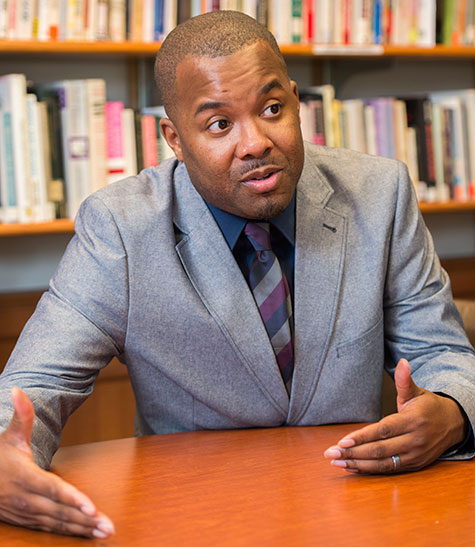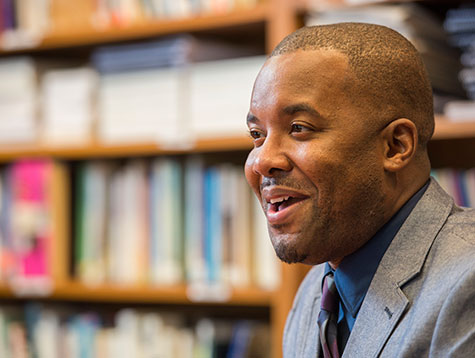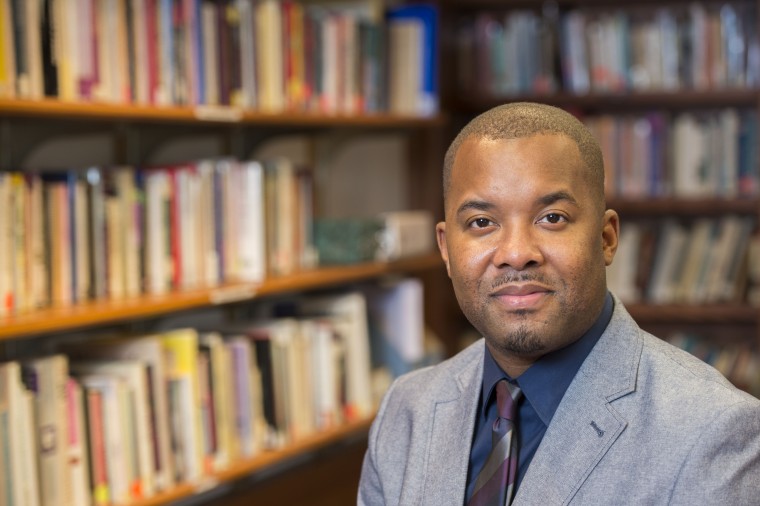Aug. 9 marks the one-year anniversary of the shooting of Michael Brown. But the conditions that contributed to the killing were long in the making, and the movement his death inspired is far from over. So says Jeffrey McCune, PhD, associate professor at Washington University in St. Louis and a regular presence in Ferguson over the last year.
Last spring, McCune and two colleagues — Clarissa Hayward, PhD, associate professor of political science in Arts & Sciences, and Meredith Evans, PhD, associate university librarian — began collecting oral histories of the Ferguson movement as part of The Divided City, an urban humanities initiative that aims to examine historical forms, and the contemporary reality, of urban separation.
Funded in part by a grant from the Andrew W. Mellon Foundation, The Divided City is organized by the Center for the Humanities in Arts & Sciences and by the Sam Fox School of Design & Visual Arts’ College of Architecture and Graduate School of Architecture & Urban Design.
Other recent projects receiving grants from the initiative range from “Segregation by Design” and “Visualizing Urban History,” which explore the role of the built environment, to the video production class “Tale of Two Cities,” which this fall will begin documenting local reform efforts.
We sat down with McCune, who has joint appointments in the Women, Gender, and Sexuality Studies program and the Performing Arts Department, both in Arts & Sciences, to discuss Ferguson, activism and voices on the edge.
When Michael Brown was killed, you cut short a research trip and returned to St. Louis for a vigil led by local clergy. What were those early days like?
In some ways, the clergy vigil on the day after was emblematic of the movement. You had old-school civil rights prayer warriors joining together to talk about peace and reconciliation. And you had young people in the middle of the street saying, “[expletive] the police, justice for Michael Brown.” It was a different energy.
I see the Ferguson movement as a conversation between those two perspectives. There is prayer and preaching, but also a more radical space of protest, rhetoric and dissent. These things all co-exist and propel the movement forward — even as some of them get a bad rap.
Ferguson sparked a flame, a big flame, and now we are on fire.

How does this generation of activists differ from earlier generations?
Partly it’s technology. Folks get revved up because they have more access to more details more quickly than we did historically. There’s a sense of immediacy to what’s going on, and an immediacy to the reaction.
Ferguson is interesting because at base we had a very multicultural coalition. Folks were very serious about what was done to Mike Brown, but the history of anti-blackness within this country was taken up by white, brown and black, Asian and Latino, gay and lesbian … It’s a heterogeneous movement that announces itself as such.
For example, the Black Lives Matter movement may appear to be all about race, but we know that the progenitors included black queer women who were as concerned about queer issues and women’s issues as they were about black issues. They saw them all as collectively marginalized identities.
You’re particularly focused on collecting oral histories from self-identified activists. Why emphasize that perspective?
Part of what we’re doing, my co-investigators and I, is trying to account for voices on the edges. One mantra of Black Lives Matter is that it’s all about the issues, not about whoever the media determines is “the voice of the movement.” We want to carve out space to explore how activists — who might not be among the known players — go about doing what they do.
You direct the Mellon Mays Undergraduate Fellowships, which encourage students with a demonstrated commitment to increasing cross-racial and ethnic understanding to pursue doctoral degrees. You’ve also gone on record to discuss the conflicts some have felt, in the wake of Ferguson, about pursuing academic vs. activist work. Does this project bridge that divide?
Definitely. We’ve had a lot of conversation around this notion that many academics don’t see their work as activism. But that view can foreclose the possibility of actually taking action.
I see this project as an opportunity for the community to teach us and for us to collaborate with the community. These histories provide tremendous opportunities to explore the intersection of history, culture, gender, sexuality, race, anthropology, sociology and American studies. We want to make sure they’re not just contained within our individual silos.
Much of this material will be freely available to the public — as are visual images already collected through the [University Libraries’] Documenting Ferguson archive. Years from now, these archives will help people look back and make sense of their experiences, to regenerate themselves and reinvigorate their passions.
You’ve worked with the local community to develop interview protocols, and one of your research fellows, Alexis Templeton, has been a key Ferguson organizer. In broad strokes, what sorts of questions are you asking?
First, we want folks to narrate their beginnings in the movement. How did you get started? What was the impetus? How did you come to understand yourself as an activist?
The second layer is thinking through experiences. Many folks have participated in multiple — if not hundreds — of demonstrations. Many have been incarcerated, or subjected, like myself, to tear gas and other things. So, what was that experience like? What did you see? What did you feel? Who was there with you?
Finally, where do you see the movement going? What might it look like in five, 10 or 15 years? What actions could it be taking?

What have you learned so far? What has surprised you most?
It’s surprising to see the different points at which people got involved. Some began immediately after Michael Brown’s killing, but others came later — after VonDerrit Myers, or after Tamir Rice. People came because a friend was going, or a friend of a friend, or it was happening down the street and they wanted to be part of the noise.
People got involved via Twitter or Facebook. People came because they didn’t want a partner to be out there alone. Some people had questions about Michael Brown but, after seeing multiple violences of this type, came to understand the issues as systematic.
Another thing that comes up is the notion of exhaustion. People get on and off the train. There’s frustration and burnout and feelings of betrayal — the idea that certain people are advancing themselves, rather than the cause of black people.
The Ferguson movement is one of the most efficient, efficacious and powerful America has seen. But it’s not easy. It’s messy and complicated. Everybody is committed, but everybody doesn’t always get along. I’m hopeful that as we gather more narratives, we’ll be able to see the movement in all its heterogeneous complexity.
